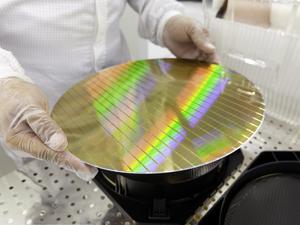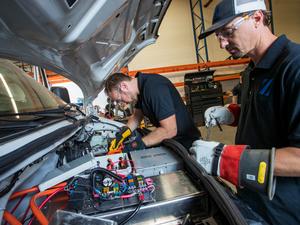The Arizona semiconductor industry has stepped into the limelight this year thanks to the pandemic-induced chip shortage and the massive Valley investments in the works from Taiwan Semiconductor Manufacturing Co. and Intel Corp.
The region is home to sizable chipmaking operations, but it’s also a place where chip innovation happens. Most recently with Ambature Inc., a Scottsdale chip design company that announced new test results for its superconductive building process last week.
Specifically the company is using a composite of yttrium barium copper oxide (YBCO) to build its architecture along the a-axis. Put plainly, Ambature uses a material that’s more conductive than silicon and builds vertically instead of horizontally.
This redesign takes place on the microscopic face of a computer chip. Ron Kelly, CEO of Ambature, told the Business Journal that this new process will potentially help put better chips in all kinds of end products.

“We are the first company to actually prove that you can build a vertical structure architecture superconductor,” he said. “That is one of the biggest innovations that has happened in Josephson Junctions in some time.”
The Josephson Junction, or JJ, is named after Brian Josephson, a 1973 Noble Laureate who did foundational research into superconductivity. Now, just a few decades later, Ambature’s JJ device innovation paves the way for more advanced chips in medical imaging, internet of things edge sensors, data centers, machine learning, quantum computing and more.
Ambature’s tech has been independently tested by NASA’s Jet Propulsion Lab in California, and Kelly said that the company also owes its success, in part, to Arizona State University.
“The bulk of this technology was done in the engineering labs at Arizona State University,” Kelly said. “When I tell you we have 3,700 individual patent claims, probably 95% of that was done here at Arizona State University because we could go in, not have to spend huge capital amounts of money to buy that equipment, and just use it.”
Ambature has offices in Scottsdale and Waterloo, Canada and with these new test results it’s able to start heading to market by licensing its intellectual property to other chip designers and manufacturers. Kelly also said that even though Ambature's JJ design is new to the field, it can be built with existing equipment in any fab.
The nitty gritty
Semiconductors have become central to much of the technology that drives the modern world; Everything from vacuum cleaners and coffee pots to video games systems, cars and TVs rely on computer chips to function.
The Ambature vertical architecture is tiny, but it opens the door to big ideas including quantum computing. The vertical construction helps by increasing coherence length by up to 10 times what can be done with horizontal construction, which increases stability and control of the electrical current used in these systems.
Additionally, the vertical construction helps to lessen heat loss caused by electrical resistance, like when an overworked computer or smart phone gets warm to the touch. The Ambature design is a low-heat superconductor, so it transmits the electrons more efficiently without the loss of energy — in the form of heat — along the way.
Ultimately, a faster, more efficient and more reliable computer chip is the foundation around which all other future technology will be built. Kelly said that in the near term superconductors and semiconductors will sit on the same chip, but one day the semiconductor may fall by the wayside as superconductors take their place.











